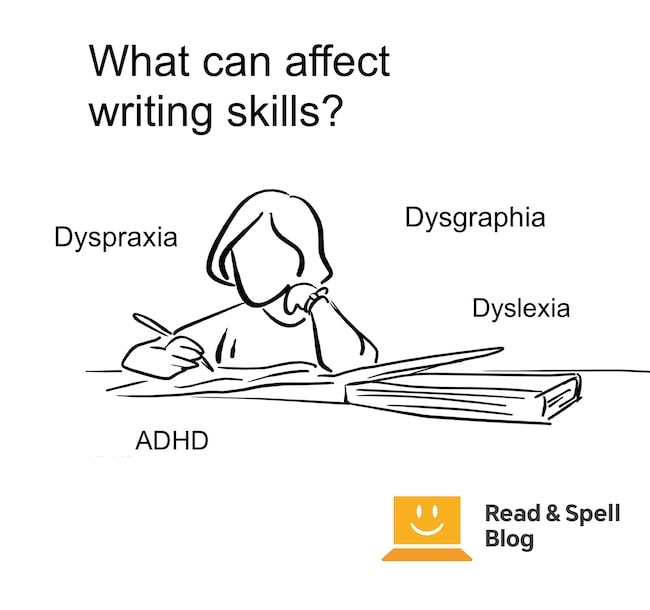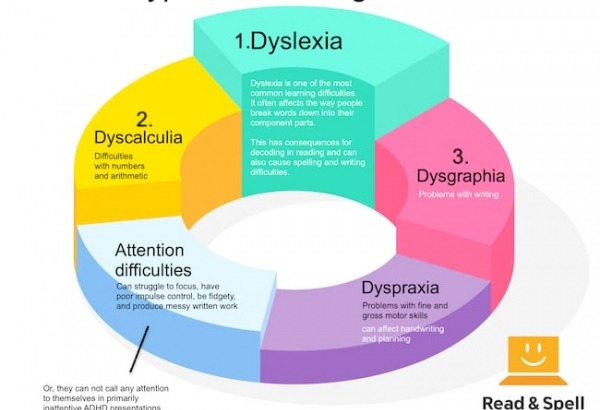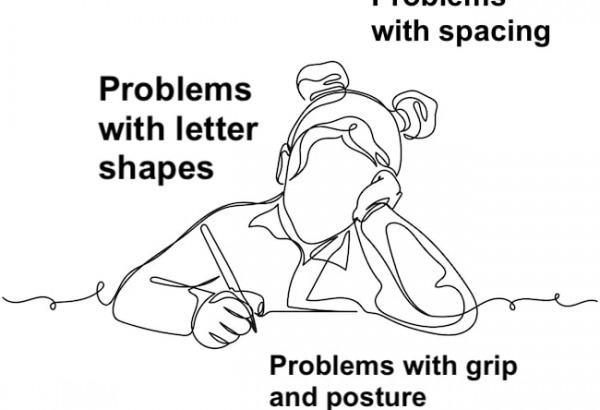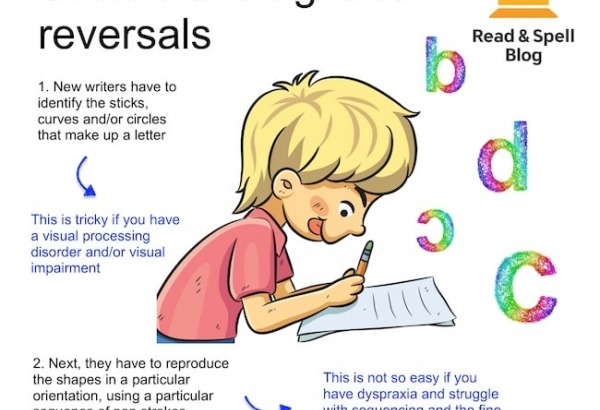Difficulty writing

Writing is a complex and cognitively demanding task that requires a child to bring together both lower and higher order skills, including manipulating abstract ideas while paying close attention to the spelling and punctuation conventions of written English.
If the physical act of putting letters on a page is problematic or a learning difficulty gets in the way of fluent language production, students may struggle to come up with legible and coherent compositions. This can lead to poor grades on quizzes and tests but can also affect learning when note-taking skills are compromised.
Because writing is central to most subjects across the school curriculum, over time poor performance on written assignments can result in negative associations with classroom learning, low self-esteem and a general lack of confidence at school. A child may believe he or she is a bad writer and begin to avoid writing activities, which in turn results in a less developed skill set.
The tragedy is that with the right strategy training and appropriate accommodations, every child can achieve his or her full potential.
Learning to read and write
Many children begin learning how to read and write by the age of six. Success in early-literacy skills development is related to a child’s familiarity with the alphabet and also his or her ability to hear the sounds that make up words.
Decoding (sounding out words in reading) is the inverse operation of encoding (spelling) in writing and is why reading and writing skills develop in tandem. Both processes require the breaking down of words into phonemes and pairing of sounds with the appropriate letter or letter combinations.
English is considered a challenging language in this respect because there are more sounds than letters. That means readers will encounter different spellings that represent the same sounds, as well as words that do not conform to spelling rules. Both require memorization of the final word forms. Learn more about English spelling and phonics instruction as a method of teaching reading in these articles.
The mechanics of handwriting
In order to develop handwriting ability, a child must possess the fine motor skills to hold a pen or a pencil and the hand-eye coordination needed to form letters. Letters in English are made up of “balls and bats,” circles and curves paired with lines. Writing skills require practicing the pen strokes needed to create each letter and are learned through copying exercises.
Capital letters are more similar in shape to each other than lower-case letters, which is one reason why some children prefer to write using all caps.
Learning to write in cursive is even more challenging given letters can change shape depending on where they occur in a word, as well as join up at different points. Letter writing becomes more regular with practice, and in the beginning, reversals and flipping are common.
However, if a child is still reversing letters in third and fourth grade it may be a sign of a learning difficulty. Learn more in our post on reversals. As a child’s writing becomes neater they will also get faster. Note that this may not be the case for all learners.
Thinking on paper
Forming written language is one hurdle but a child also needs a wide vocabulary in order to translate his or her thoughts into language. An understanding of English punctuation is important and a child must be able to hold abstract thoughts in working memory and produce grammatically sound sentences. The more a child writes, the easier this process becomes. It can be learned via plenty of free writing practice preceded by brainstorming activities.
As a child advances to later grades, he or she will also need to contend with specific task restraints that help to inform the kind of information included and the language and format in which an answer should be given. Writing must be organized in such a way that ideas flow logically and paragraphs are connected via transitions.
The more a child reads, the more he or she will be exposed to these features in writing and begin to adopt similar techniques in his or her own work.

Learning difficulties, motor skills disorders and attention disorders that can affect writing
Dysgraphia
Dysgraphia is a writing-based learning difficulty that may prevent children from producing legible or comprehensible text. It can affect letter formation, handwriting, spacing, spelling, grammar and more. Learn about the signs of dysgraphia.
Dyspraxia
Dyspraxia causes fine motor skills difficulties which may make holding a pen or pencil painful. It can also cause issues with the planning and sequencing of information in writing.
Dyslexia
Dyslexia can cause issues with spelling and reading—which makes revising work challenging. The root cause of spelling difficulties can have to do with hearing the sounds that make up words. Learn more about dyslexia.
ADHD
ADHD can result in problems focusing on a writing prompt, sticking to a topic, and impulsivity. The latter may lead to crossing out words and erasure marks, which can make written work quite messy.
While not always classed as having learning difficulties, gifted children and learners who are on the autistic spectrum sometimes experience difficulty sticking to a topic.
Children with visual processing difficulties may have trouble with copying exercises and handwriting in general.

7 Writing difficulties and how to help
- Trouble getting started
Staring down at a blank page is never easy but creating a mind map is a great way to get things going. This will help a child think about the topic and generate some vocabulary before writing. Teachers might also have students brainstorm a list of ideas as a class. If you find kids have a hard time coming up with ideas, you can divide them into groups and give out discussion topics to spur conversation.
Keep in mind that a lot of worksheets used for mind maps are full of small boxes and circles in which students are instructed to record their answers. These sheets can be a nightmare for a child who struggles with the mechanics of writing, especially those kids with dysgraphia or dyspraxia, so a freeform response might be more appropriate. TOP TIP: There are apps for tablets that allow students to photograph classroom worksheets and annotate them electronically.
- Anxiety and a lack of confidence
Anxiety can make it hard for a child to write. Anxiety might be the result of past failures, a lack of self-confidence or misconceptions about the writing process, especially that a first draft should be perfect. Teach kids that writing happens in stages and the goal isn’t to produce a perfect sentence on their first try. You can do this by not correcting a rough draft for spelling or grammatical errors.
Instead, provide feedback on ideas and sequencing as well as encouragement and praise for language use. When a child becomes more confident, peer editing activities can also be useful but this may depend on the personalities in a particular class.
- Difficulty with self-expression
Sometimes a child may struggle with expressing him or herself in writing. This is rarely about a lack of self-knowledge and more often related to vocabulary or spelling skills. A child may be hesitant to put a word down for fear of making a spelling mistake or simply have trouble producing the written language needed to capture an idea.
If you notice a large gap between spoken and written ability, a specific learning difficulty like dyslexia or dysgraphia might be causing the problem. Discuss it with your child’s teacher. The earlier a learning difficulty is assessed, the greater the chances you can provide the right accommodations and strategy training to help him or her.
- Trouble organizing ideas
Some children have trouble putting their ideas into a logical order. To help with the organization of ideas, practice with word and sentence cards. You may want to make cards with main ideas and details written in different colors and talk through the best way to arrange them. At later stages, photocopy a child’s work and cut his or her own sentences out so they can be rearranged and then rewritten in the new order. You might also provide a few blank cards so new ideas can be added to aid with transitions and help a piece flow.
- Having a hard time sticking to a topic
For some learners, the issues is not in writing but rather producing written work that stays on topic. For example, gifted children may prefer to answer only one part of a prompt, particularly if they don’t find the assignment challenging enough. The impulsivity characteristic of ADHD can also cause children to focus on just one aspect of a topic.
While it isn’t necessarily advised to mark a child down for this (which can be demotivating), one strategy might be to encourage writing in stages to help students narrow the scope of their writing in later drafts.
- Poor spelling, spacing and punctuation
While over-correcting spelling and punctuation can be demotivating, these are still aspects of writing a child needs to learn. In order for surface level features to show up consistently and correctly in written production, they first have to be noticed and learned. Mock editing activities can help this process along.
Give the child a red pen and ask him or her to go through and annotate unpunctuated text. Provide a list of correctly spelled words and in a new color have them do a search for misspelled vocabulary—you may even include a prize such as a sticker for each error found. This teaches children how to proofread and these skills can then be applied to their own work.
- Messy handwriting
In elementary school almost all writing is done by hand, which makes handwriting ability a major focus in the classroom. Nonetheless, in later grades and high school, much of an individual’s writing will be produced on a computer. Moreover, for a child with motor-skills difficulties writing by hand can be painful, frustrating and a de-motivating experience that actually prevents him or her from generating ideas and thinking about language. (Note children with messy handwriting are not being lazy!)
That’s why in many cases of dyspraxia and dysgraphia it’s advised a child learns how to touch-type so he or she can use a computer at an earlier age. In touch-typing muscle memory in the hand and fingers is harnessed to automatize spelling and no attention is needed for letter production. Mistakes can be corrected without any embarrassment and ideas flow freely through the fingertips and onto the screen.
The benefits of developing writing skills
Helping kids develop their writing skills is important to keep future education and career opportunities open. Writing also offers another outlet for creativity and self-expression that can help children tune in to their own emotions and process their feelings. For example, writing a diary or journal is helpful when kids experience frustration and negative emotions. This is especially the case if these emotions are a result of a specific learning difference. If writing a journal by hand isn’t possible, electronically typed entries or video diaries are great alternatives.
Moreover, with today’s emphasis on technology, writing online in forums, on websites and on social media is increasingly important for social interaction. While it is different from the writing learners do at school, any training in written production increases automaticity and helps words and ideas flow more readily onto the page (or screen!). The more a child writes, the more confident he or she will feel about the skill and the less it becomes an unknown or anxiety producing task.
Resources and tools
Scribeasy
When it comes to helping a child become a more proficient writer, the startup Scribeasy has developed an excellent and cost-effective solution that helps learners generate ideas using image prompts and stickers which can be applied to various settings, incorporating drag and drop technology to help get a story started.
Learners can choose to write stories of different lengths working by time on task vs. word limits. They can share their stories with classmates, friends and family and gain access to a repository of other stories produced by Scribeasy users around the world. They can also like, comment and get inspired as they go.
Touch-type Read and Spell
To help children use a computer based writing program like Scribeasy and/or support students with learning difficulties and those who have a difficult time writing by hand, Touch-type Read and Spell is an optimal solution that provides instruction in touch-typing, specifically geared for users who want to focus on developing accuracy over speed.
The platform is based on a program of phonics so learners strengthen spelling and reading skills as they learn how to type. TTRS has helped learners with dyspraxia, dyslexia and dysgraphia achieve more in writing.
Learn more about dysgraphia and writing difficulties in these articles: Handwriting difficulties, Dysgraphia vs. dyslexia, Strategies for dysgraphia, Dysgraphia symptoms in children, Letter reversals in writing
For learners who struggle with dysgraphia
TTRS is a program designed to get children and adults with dysgraphia touch-typing, with additional support for spelling.
Chris Freeman
TTRS has a solution for you
An award-winning, multi-sensory course that teaches typing, reading and spelling

How does TTRS work?
Developed in line with language and education research
Teaches typing using a multi-sensory approach
The course is modular in design and easy to navigate
Includes school and personal interest subjects
Positive feedback and positive reinforcement
Reporting features help you monitor usage and progress














